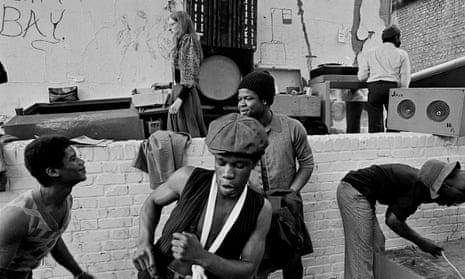London, 1962: the Rolling Stones make their debut at the Marquee Club and the Beatles arrive from Liverpool to record their first single, Love Me Do. Across the Channel, the “French Elvis” Johnny Hallyday, Françoise Hardy, Georges Brassens and Brigitte Bardot are topping the music charts.
So far, so European, but the music scene in both capitals would soon undergo a profound transformation. Waves of migrants shipped to London from newly independent British West Indian colonies – the Windrush generation – and to Paris from former French colonies in north and sub-Saharan Africa, were trying to adapt to new lives and make themselves heard. Many did so through music.
A new exhibition reveals how a musical phenomenon that began in the backstreet bars of Soho and Camden town and the cafes of the Parisian banlieue, transformed both capitals into the multicultural cities they are today.
Paris-Londres, Music Migrations 1962-1989, which opens next month at Paris’s Musée de L’Histoire de L’Immigration, traces how migrant music influenced popular trends as well as political and social movements and became a tool to fight racism, inequality and oppression and foster integration.
The exhibition features more than 600 items, including photos, concert posters, videos, magazines, instruments and costumes, plus some of the most celebrated recordings from the three decades.
“In a European context where nations are looking inwards and wishing to close their borders. The exhibition, which opens at the time of Brexit, is at the heart of the most burning current affairs,” says the catalogue.
Curator Stéphane Malfettes told the Observer that one aim of the exhibition was to counter current negative attitudes towards migration. “We want to show that with the migrants came artists and composers and their music, and that this music from elsewhere brought a richness that’s part of our heritage.”
“And the common denominator is that this diversity is a mark of the success of integration.”
The exhibition’s point of departure is 1962, when former British territories Jamaica, Trinidad and Tobago became independent; in the same year, Algeria won its independence from France after an eight-year war.
In Britain, the Swinging 60s were defined by Beatlemania, rock’n’roll bands like the Rolling Stones, the Who and the Kinks, and an explosion of fashion and culture. It was a chaotic, colourful and increasingly drug-fuelled revolution that shook off the bleak, black-and-white, deeply conservative 1950s.

West Indian youngsters, marooned in this cultural maelstrom and kicking their heels in inner-city estates, took refuge in their musical roots: ska, bluebeat and rocksteady. Among their heroes were Millie Small, whose 1964 hit My Boy Lollipop became one of the top selling ska songs of all time, and Desmond Dekker, whose 1969 record Israelites was embraced by young white working-class youngsters and mods. Later, Bob Marley and the Wailers, Aswad and Steel Pulse would storm the British and international music scenes with reggae and roots reggae – highlighting the struggles and aspirations of the African diaspora – and inspiring bands such as the Clash and the Specials .
In Paris, musicians from Algeria, like Cheikha Rimitti and Noura, and from sub-Saharan Africa, including Papa Wemba, Salif Keita and Mamadou Konté had begun to record. “The experience of the two capitals was similar but different,” Malfettes said. “With reggae there was a universal phenomenon – this small island, Jamaica, producing music that became popular around the world. It took hold very quickly. The spread of migrant music took longer in Paris. We had a lot of artists from north Africa who were recording, but they were marketed for an audience in north Africa, or for their own communities here.”
By the 1970s, as both British and French governments toughened immigration policies in the wake of the international petrol crisis, and the far right gained ground, the music became more political.
In London, the Caribbean community organised the Notting Hill carnival to promote cultural unity, while Rock Against Racism concerts in the UK and Rock Against Police concerts in France sought to counter an increasingly hostile atmosphere for migrant communities.
“In Paris in the 1970s, African artists became politicised with the extreme left in a movement that made much use of music to recount the stories of immigrant workers. It was a movement of struggle. Not all African music was political, but it took on a political aspect. Even if it was very trendy and popular, the lyrics were very politically engaged,” Malfettes said.
Moving into the 1980s, the exhibition covers the emergence of rap, bhangra, Asian underground, R&B and modern raï. “The 60s to the 80s are three decades where music progressively occupied a more important place in the battle for and construction of identity and the idea of vivre ensemble, living together. Music was the factor that united the diversity of Paris and London, especially in the struggle against racism,” Malfettes added.
“At different moments of this history between the 60s and 80s, music played a fundamental role in integration. It was about cultural pride and also resistance, and it allowed communities to counter racist ideas during the period of strong racism in the 60s and 70s. Unfortunately, there’s a feeling that ground has been lost since the 1980s, and this idea of utopia and vivre ensemble is receding .When we speak of music in France, we rarely speak of those influences from the Caribbean and north and sub-Saharan Africa that are so much part of French heritage. But music remains something that unites different peoples.”
Hélène Orain, the Paris museum’s director, said the exhibition celebrated a “post-colonial turning point” in Britain and France that saw migrant communities using music to express their “grievances, visions and hopes”.
With Brexit looming large, however, she said it had another important message. “The destinies of our two countries may be separating, but we are still linked and we will continue to recount our common history.”
Paris-Londres: Music Migrations (1962-1989) is from 12 March 2019-5 January 2020
